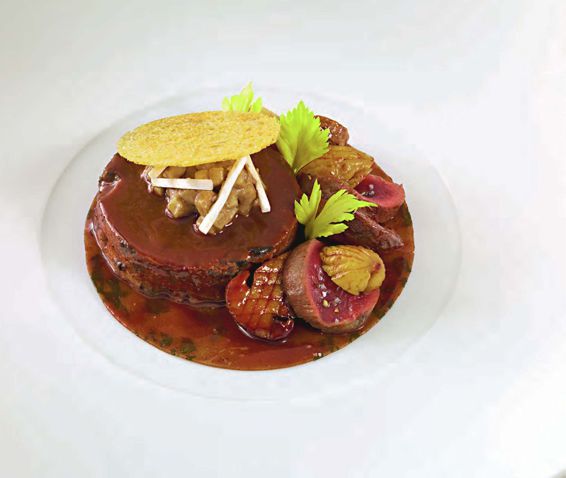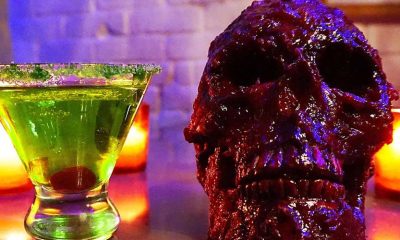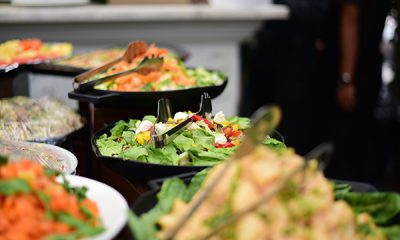Food Blogs
Wild Hare A La Royale Recipe
LEGEND HAS IT that lièvre à la royale, a gut-warmer fall dish, was first invented for Louis XIV, who loved the gamy beast but had no teeth left, thus requiring that the meat be cooked long and slow until it became so tender that he could savor it with a spoon.
Culinary luminaries tell us that there are two different lineages for this icon of French gastronomy: Senator Couteaux’s recipe—a slow-braised whole animal huddled in a dark, heady sauce; and Marie-Antoine Carême’s, which favors, as I do, a completely deboned version. Like many great classic recipes, this preparation requires three days to complete. Today at Daniel, we harness the power of the hare with silky foie gras, specks of truffle, and a drop of deep Cognac for a noble stuffing.

| Servings |
MetricUS Imperial
|
Ingredients
Butchering the Hare
- 2 wild Scottish hare 2½-pound
Braised Hare Leg Roulade and Hare Sauce
- 4 hare legs bone-in, reserved from above
- 4 ounces bacon cut into large dice
- 2 cups full-bodied red wine
- cup ¼Cognac
- 1 medium carrot peeled and diced
- 1 large onion diced
- 1 stalk celery diced
- 4 cloves garlic peeled
- 1 tablespoon sachet (1juniper berries 1black peppercorns, and 2 sprigs thyme wrapped in cheesecloth and secured with butcher’s twine)
- Salt and freshly ground white pepper
- 2 tablespoons duck fat
- Hare bones reserved from above
- 3 quarts Veal stock
Hare Sauce Liaison
- 9 tablespoons butter
- 2 ounces ½Foie Gras Terrine
- 4 ounces ½fresh pork blood
- 1 teaspoon Cognac
Hare Royale Farce
- 2 tablespoons olive oil
- 6 ounces fresh black trumpet mushrooms trimmed, rinsed, and patted dry
- Salt and freshly ground white pepper
- 2 cloves garlic peeled and thinly sliced
- 3 ounces diced crustless white bread
- cup ¼hot milk
- 1 pound fresh deveined grade A foie gras lobe cut lengthwise into four 4-ounce slices
- 20 ounces hare meat reserved from above (14roughly chopped and 6cut into small dice)
- 12 ounces ½fatback 3½roughly chopped and 9cut into small dice
- 4 hare kidneys small-diced
- 2 hare livers small-diced
- 2 hare hearts small-diced
- 7 ounces chopped fresh black truffle
- 1 ounces ½truffle juice
- 2 ounces ½hare sauce reserved from above
Seasoning ratio for each pound of hare farce
- 1 teaspoon Salt 6 grams
- teaspoon ½ freshly ground white pepper 1.5 grams
- teaspoon ½ Cognac 2.5ml
Foie Gras Melba
- 8 slices very thinbrioche
- 2 tablespoons foie gras fat reserved from above
- Salt and freshly ground white pepper
Hare Royale Ballotine
- 2 hare loins reserved from above
- Salt and freshly ground white pepper
- 3 ounces fresh black truffle chopped
- 1 egg white beaten
Chestnut-Parsley Pasta
- 1 cup plus 3 tablespoons chestnut flour
- 1 cup plus 3 tablespoons type 00 soft wheat flour
- 7 ounces egg yolks
- cup ½parsley leaves
- Salt
- 1 tablespoon olive oil
Porcini Marmalade
- 1 pound large porcini mushrooms caps separated and wiped clean, stems peeled, about 6
- 2 cups dry white wine
- Salt
- 2 sprigs thyme
- 3 cloves garlic peeled and smashed
- Freshly ground white pepper
- 3 cups olive oil or as needed
- cup ¼heavy cream
- white balsamic vinegar
Roasted Chestnuts
- 2 tablespoons butter
- 12 fresh or vacuum-sealed peeled chestnuts
- Salt and finely ground white pepper
- 2 tablespoons Cognac
- 3 tablespoons hare sauce from above
To Finish
- ounce ½unsweetened baker’s chocolate
- Salt and freshly ground white pepper
- 8 small porcini mushrooms cleaned and halved
- 4 tablespoons olive oil
- 2 cloves garlic peeled and smashed
- 2 sprigs thyme
- 2 tablespoons butter
- 2 hare loins trimmed
- 24 small celery leaves
- cup ½lightly whipped heavy cream
Ingredients
Butchering the Hare
Braised Hare Leg Roulade and Hare Sauce
Hare Sauce Liaison
Hare Royale Farce
Seasoning ratio for each pound of hare farce
Foie Gras Melba
Hare Royale Ballotine
Chestnut-Parsley Pasta
Porcini Marmalade
Roasted Chestnuts
To Finish
|

|
Instructions
For Butchering the Hare
- On a large cutting board, lay the hare on their backs. Pull the kidneys, livers, and hearts from the belly cavities and peel off and discard the fat surrounding the kidneys; reserve for stuffing.
- With a butcher’s knife, trim away the shoulders (forelegs) by cutting flush up against the neck bone, and then bend the shoulder forward to pop the bone from the joint. Carve through the joint toward the ribs to completely remove. Debone the forelegs, reserving the meat for the farce and bones for the sauce.
- Remove the legs by carving inward to separate the thigh from the tailbone, pop the bone from the joint, and carve through the joint toward the tailbone to completely remove; reserve for braising.
- Carve the tenderloins from underneath the saddle; reserve for the farce. Turn the saddles over and carve the loins from the backbone. Cut away the silver skin from the loins in strips and discard. Trim the loins to 5-inch lengths and reserve for roasting; reserve the trim for the stuffing.
- Chop all the bones into rough 1-inch pieces, rinse with cold water, dry, and reserve for the farce.
For the Braised Hare Leg Roulade and Hare Sauce
- In a shallow container, combine the hare legs, bacon, red wine, Cognac, carrot, onion, celery, garlic, and sachet. Cover and marinate, refrigerated, overnight or up to 24 hours.
- Preheat the oven to 300°F. Strain and reserve the liquid from the marinated ingredients and pat them dry. Separate the bacon and legs from the vegetables and sachet. Season the legs with salt and pepper on all sides. Place a large heavy-bottomed Dutch oven over medium heat and add the duck fat and bacon. Cook, stirring, until the bacon is browned, 4 to 5 minutes, then remove with a slotted spoon and set aside. Add the hare legs and sear on all sides until golden brown, 8 to 10 minutes; remove and set aside. Add the bones in a single layer (you may need to do this in batches). Roast on all sides until browned, 10 to 12 minutes. Remove the bones, set aside, and reduce the heat to medium. Add the marinated vegetables and sachet to the pot. Cook, stirring, for 5 minutes. Add the reserved marinating liquid to the pot, bring to a simmer, and reduce by half, about 20 minutes. Return the bacon, hare legs, and bones to the pot and stir in the veal stock. Bring to a simmer, cover, and transfer to the oven. Braise for 2 to 2½ hours, until the leg meat easily separates from the bones. Remove the legs from the liquid, transfer to a baking dish, cover with plastic wrap, and reserve in a warm spot. Strain the braising liquid through a fine-meshed sieve into a large saucepan and discard the solids. Bring to a simmer and reduce, occasionally skimming away any foam that rises to the surface, for 2 hours, or until it is thick enough to coat the back of a spoon. Reserve the sauce, chilled.
- Meanwhile, pick the hare meat from the legs into a medium bowl and add a few spoonfuls of cooking liquid to keep it moist. If needed, adjust the seasoning with salt and pepper. Line a flat surface with a horizontal 2-foot-long double layer of plastic wrap. Spoon the braised hare meat into the center of the plastic in a 1-foot-long horizontal mound. Lift the bottom edges of the plastic wrap and fold over the meat to meet the top edges. Using your fingers, form the meat through the plastic into a 1¼-inch-diameter log, then roll the log forward to enclose in the plastic. Tie off the ends of the plastic to secure and refrigerate until fully chilled.
For the Hare Sauce Liaison
- In the bowl of a food processor, pulse the butter with the foie gras terrine until well combined. With the machine running, slowly stream in the blood and Cognac until homogeneous. Transfer to a small container, cover, and reserve, chilled.
For the Hare Royale Farce
- Be sure that all meats are well chilled. Heat the olive oil in a large sauté pan over medium-high heat. Add the mushrooms and sprinkle with salt and pepper. Sauté until tender, about 4 minutes, adding the garlic halfway through, and transfer to a cutting board. Finely chop and reserve, chilled. In a small bowl, soak the bread in the milk for 5 minutes. Squeeze out excess milk, weigh out 4 ounces of bread, and set aside.
- Heat a large dry sauté pan over high heat until very hot. Add the foie gras and sear for 10 to 20 seconds on each side, until lightly colored (it should not cook through). Transfer to a plate and refrigerate, reserving the fat in the pan for the foie gras melba. Once chilled, cut the foie gras into small dice.
- Pass the 14 ounces of roughly chopped hare meat and 3½ ounces of roughly chopped fatback through a meat grinder fit with the coarse plate. Transfer to a large bowl and add the chopped mushrooms, soaked bread, 6 ounces diced hare meat, 9 ounces diced fatback, the kidneys, livers, hearts, diced foie gras, black truffle, truffle juice, and hare sauce. Weigh the mixture and measure the needed amount of seasoning according to the ratio listed in the ingredients; sprinkle it over the top. Mix well, cover with plastic wrap, and refrigerate overnight.
For the Foie Gras Melba
- Preheat the oven to 225°F. Using a 2½-inch ring cutter, cut the brioche slices into discs. Brush 2 sheets of parchment paper with foie gras fat on one side. Place 1 on a baking sheet, fat side up, and line the brioche on top in a single layer; sprinkle with salt and pepper. Top with the second sheet of parchment fat side down. Top with another baking sheet and bake for 18 to 20 minutes, until they are crisp but not colored. Cool, then store in an airtight container.
For the Hare Royale Ballotine
- Using an immersion circulator, preheat a water bath to 144°F. Season the 2 hare loins with salt and pepper. Line a flat surface with a 2-foot-square double layer of plastic wrap. Spread the hare royale farce in the center of the plastic into a flat, approximately 1-foot-long and 10-inch-wide rectangle. Sprinkle the truffle evenly over the top. Brush the hare loins with the egg white and lay on the stuffing in a horizontal line approximately 3 inches from the bottom edge. Lay the braised hare log on top of the loins. Using the plastic wrap as an aid, begin rolling the farce away from you, up and around the top of the braised hare loins and roulade, and then roll forward to completely enrobe. Roll the ballotine in the plastic a few times to tighten and then tie off the ends. Transfer to a sous-vide bag and vacuum-seal. Submerge in the prepared water bath and cook for 24 hours. Transfer the bag to an ice bath until fully chilled through the center and remove from the bag. Unwrap the plastic and slice the roulade into 8 equal portions; reserve, chilled.
For the Chestnut-Parsley Pasta
- Sift the chestnut and 00 flour into the bowl of a stand mixer fitted with a hook. Begin mixing on low speed; gradually add the yolks until just combined. Increase the speed to medium and mix until the dough comes together and begins to pull from the sides of the bowl. Remove the dough and continue to knead by hand for 3 minutes. Flatten the dough into a 3 × 4-inch rectangle, wrap in plastic, and rest in the refrigerator for at least 2 hours or overnight.
- Pass the dough through a pasta machine, gradually reducing the thickness until it is thin enough to see your hand through. Lay the sheet of dough horizontally on a flat surface and line the parsley leaves on top of half of the length, facing outward, touching but not overlapping. Lightly brush the other half of the pasta with water and carefully fold on top, pressing lightly to stick together. Increase the thickness on the pasta machine three notches and run the pasta through twice, then decrease the thickness one notch and run through again, being careful not to tear; you should be able to see the parsley through the sheet. On a lightly floured cutting board, using a 5-inch ring cutter, cut out at least 8 discs of pasta.
- Bring a large pot of salted water to a boil and place a bowl of ice water on the side. Boil the pasta for 2 to 3 minutes, until al dente; immediately chill in the ice water. Strain and lay the pasta on a lightly oiled baking sheet; wrap in plastic and reserve, chilled.
For the Porcini Marmalade
- Cut ½ cup of batons from the porcini stems and reserve, chilled, for garnish. In a large saucepan, combine 2 quarts water with the white wine and a pinch of salt; bring to a boil. Boil the porcini caps and stems for 30 seconds (you may need to do this in batches). Remove with a slotted spoon and drain on paper towels. Transfer the porcinis to a large saucepan with the thyme, garlic, and a pinch of salt and pepper. Add enough olive oil to cover the mushrooms, cover, and place over low heat. Cook at just below a simmer until the mushrooms are fork-tender, about 1 hour. Remove from the heat and, with a slotted spoon, transfer the stems to a blender. Puree with the cream until smooth and transfer to a medium bowl. Scoop the caps from the oil and place on a cutting board; reserve the oil for other uses. Cut the caps into small dice and toss with the puree. Adjust the seasoning with the vinegar, salt, and pepper, and reserve, chilled.
For the Roasted Chestnuts
- In a medium sauté pan over medium heat, brown the butter. Add the chestnuts and sauté until lightly browned, about 4 minutes. Sprinkle with salt and pepper, carefully add the Cognac, and simmer until almost dry. Add the hare sauce and reduce the heat to medium-low; cook, stirring occasionally, for 8 minutes, or until the chestnuts are tender and glazed. Cut the chestnuts in half and reserve, chilled.
To Finish
- Preheat the oven to 250°F. Place the reserved hare sauce in a large saucepan and bring to a simmer. Place the sliced ballotine in a baking or casserole dish and pour in one-third of the hare sauce. Cover and transfer to the oven. Bake for 45 minutes, or until the ballotine is heated through, basting with the sauce every 15 minutes.
- Meanwhile, remove the remaining sauce from the heat and gradually whisk in the liaison, a spoonful at a time, and then the chocolate until it melts. Season with salt and pepper and keep warm (be careful not to boil, as the sauce may break; if it does, whisk in a spoonful of hot water).
- Using a small knife, lightly score a crosshatch pattern on the cut sides of the small porcini mushrooms. In a medium sauté pan, heat 2 tablespoons of the olive oil over medium-high heat. Add the mushrooms cut side down and sear until golden brown. Flip the mushrooms and sprinkle with salt and pepper. Add 1 clove garlic and 1 sprig thyme and continue to cook, basting the mushrooms and turning occasionally, until the mushrooms are tender, about 4 minutes. Reserve, kept warm.
- Transfer the porcini marmalade to a medium saucepan over medium heat and stir until heated through. Transfer the roasted chestnuts to a small sauté pan, add a few spoonfuls of hare sauce, and place over low heat, stirring to heat through. Combine 1 tablespoon butter with ⅓ cup water in a medium sauté pan and place over medium-low heat. Add the chestnut-parsley pasta and toss just to heat though.
- In a medium sauté pan, heat the remaining 2 tablespoons olive oil over high heat. Season the hare loins on all sides with salt and pepper. Sear on all sides until browned, reduce the heat to low, and add the remaining 1 tablespoon butter, garlic, and thyme. Cook, turning and basting with the butter, for 3 to 4 minutes, until the hare loin is medium-rare (130°F). Rest in a warm place for 3 to 4 minutes before slicing each one into 12 medallions.
- For each serving, place a pasta round in the center of a warm dinner plate and top with a portion of ballotine. Place a spoonful of porcini marmalade and a few of the reserved porcini batons on top of the ballotine. Arrange 3 hare loin medallions, 2 pieces of roasted porcini, and 3 halves of braised chestnut on the pasta next to the ballotine. Garnish with 3 celery leaves. Swirl the whipped cream into the sauce and spoon onto the ballotine; top with a foie gras melba.




















